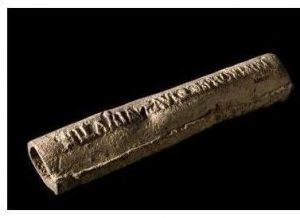In ancient Rome, water was worshipped like a deity. Its abundance not only meant the wellbeing of Rome’s citizens but was also a sign of wealth and power for its burgeoning civilization. The site of Rome is naturally well-supplied with sources of water, notably nearby springs, and easily-accessible groundwater. However, as Rome’s population grew, the demand for water rose with it. To meet this increasing demand, aqueducts and other feats of engineering were constructed.
Aqueducts carried water from springs, reservoirs, and rivers into Rome’s metropolitan area. The introduction of aqueducts to the Roman water system, starting with Aqua Appia in 312 B.C.E., allowed water from further outside the city to be utilized and thus increased the amount of water at the Romans’ disposal. When we think of aqueducts, we often recall the architecturally-striking bridges, abundant with arches. Though many of these are easily observable and well preserved, they make up only a small fraction of most aqueducts. Aqua Appia, for instance, had only 300 feet of its 11-mile length above ground. The water was primarily sent through terracotta pipes underground, which have also been unearthed by archaeologists. The pipes used were likely made of terracotta because the Romans didn’t have cast-iron technology, bronze was too expensive, and lead pipes were rarely made at such great diameters.
Aqueducts were built at a slight decreasing angle, such that the pressure would not be too great yet water would still flow in the desired direction due to gravity. When the path of the aqueduct was impeded by a valley or gorge, an aqueduct bridge was usually built, featuring the now-iconic archways that served to limit building material while preserving structural integrity. Though some aqueducts maintained their steady decline, others had features such as siphons, which carried water down a ditch and then back up it.
Cisterns were utilized by the Romans to collect rainwater as well as to collect water from aqueducts. When the water from an aqueduct reached the city, it would be stored in a cistern or distributing reservoir called a castellum. Smaller lead pipes would carry water from the castellum to either public works like fountains and bathhouses or private residences. These pipes had inscriptions embossed on their exterior indicating the manufacturer of the pipe, its subscriber, and how much water they were entitled to. By analyzing these inscriptions, we understand that private access to the water supply had to be purchased and was regulated by authorities. Citizens could buy a license to connect their property to an aqueduct, with the cost depending on the width of the pipe. This seemingly modern system also lead to some unlawful activity, however. Illegal tapping of aqueducts, widening pipes, and bribing aqueduct officials were relatively commonplace.
Though the Romans did not invent the aqueduct, its development was not only revolutionary from a technological standpoint. They pioneered the idea that water could be the property of a government and had to be paid for.
References
Rodà, Isabel
“Aqueducts: Quenching Rome’s Thirst.” National Geographic, November 15, 2016.
Johnston, Harold Whetstone.
“Johnston’s Private Life of the Romans, Ch. 16.” Forum Romanum. Scott, Foresman and Company, 1903.
https://www.forumromanum.org/life/johnston_16.html
Mays, L.
Ancient Water Technologies. Springer, 2014.
https://link.springer.com/content/pdf/10.1007/978-90-481-8632-7.pdf
Images
Figure 1
Figure 2
https://www.romae-vitam.com/ancient-roman-aqueducts.html
Additional Reading
How is LA like ancient Rome?
https://science.howstuffworks.com/environmental/green-science/la-ancient-rome1.htm
The Rise and Fall of Roman Aqueducts:
https://interestingengineering.com/the-rise-and-fall-of-roman-aqueducts



What can archaeological studies of water tell us about cultures? Why is water such a useful point of investigation in Anthropology?
Water is an important resource to study in anthropology because its implications go beyond that of just usage and technology. Firstly, water can be seen as a context in which a culture is located, and gives a sense of place to its inhabitants (Rasmussen 2013). Water, much like the sun, has also been viewed as a deity or anthropomorphized being in certain cultures (Rasmussen 2013). Studying the usage of water among a group of people can certainly tell anthropologists about that culture’s technology, for instance, if there was irrigation or water transport such as in ancient Rome. Perhaps more importantly, though, how water was viewed is telling of social and cultural practices. Water is also an incredibly important point of investigation in environmental anthropology and archaeology, as changes in water such as sea-level, drought, and flooding have a significant impact on cultures.
Reference:
Rasmussen, Mattias.
2013 “Anthropologists Exploring Water in Social and Cultural Life.” Edited by B. Orlove. American Anthropologist, January 1, 2013. https://www.researchgate.net/publication/270589051_Anthropologists_Exploring_Water_in_Social_and_Cultural_Life_Introduction
Accessed October 23, 2019